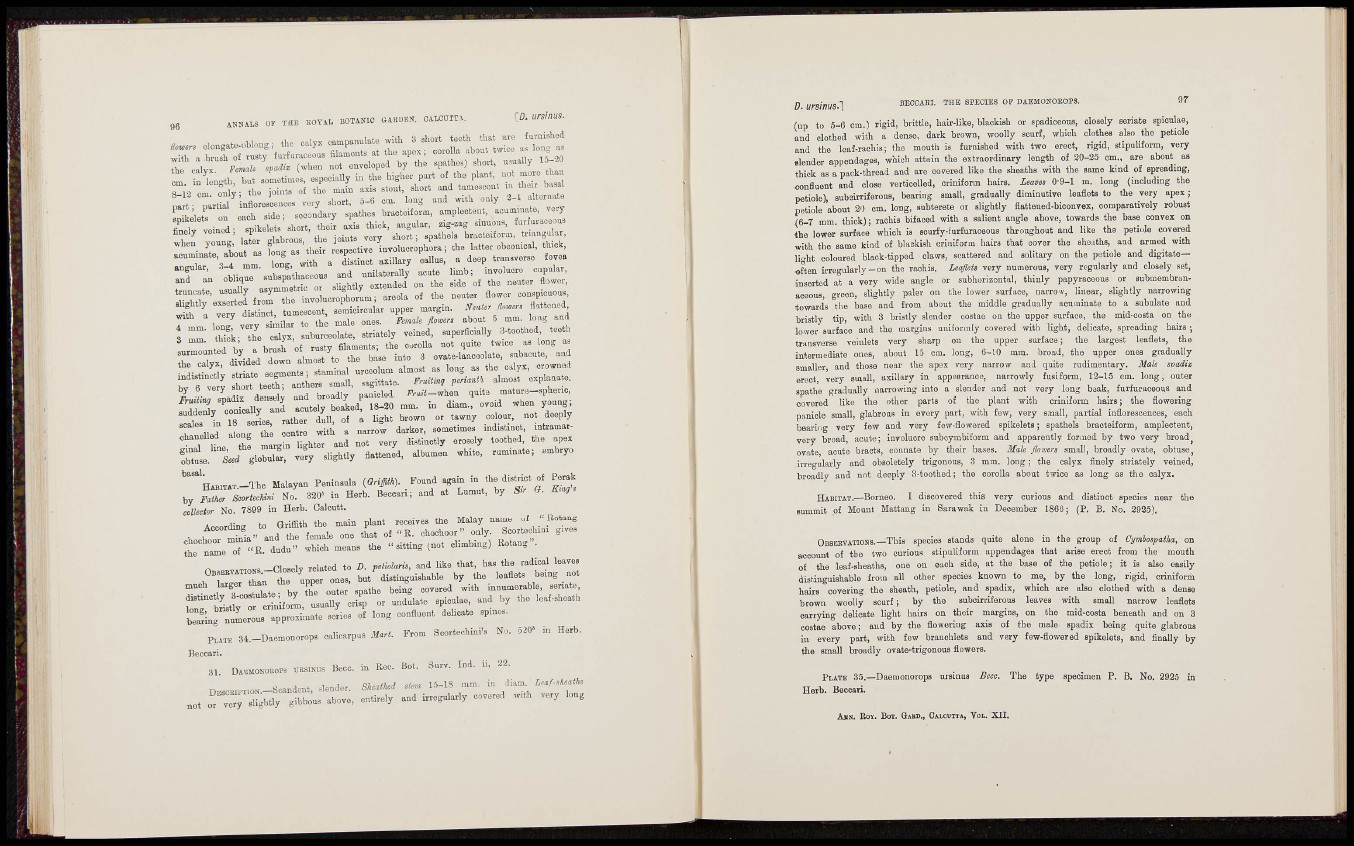
AÍOT^ALS OF THE ROTiL BOTANIC GARDEN. CALCUrTV, ro. ursinus. r.trW'ASssKff^rirjrx.';^
T a oiilT- th. ioint. of the mam oxi, stout, short and tam»oi»t theu basal
r lon7 very similar to the male ones. flomr, abeal 5 mm. long and
3 thlk the Z y . , s n W e o l a t e , striate,y veined, snperficially 3-toothed teeth
snddenJy con o y / ^^ ^^ ^^ ^^^^^^ „„t
T „ H L r t h L c™t e with a narrow darker, »ometimoa indistinct, intrama,-
.hanelled aleog ^ » , ^ r o s e l y toothed, the ape. Si. ¿rf W
' " " n ^ . T . T . - T h e Malayan Peninsnla ( f f . ^ M ) . Fonnd .«ain » i ^ ««
by Falher Soortecimi No. 320' in Herb. Beeoar.; and at Lnmnt, by »r O. ,
cMector No. 7899 in Herb. Oalcutt.
. J- t„ Griffith the main plant receives the Malay name of Kotang
^ o c h o r t l - ' a n d one t L of " R . ohoehoor" only Scorteohini give,
t I I of " R . dudn» which means the " s i t t i n g l n o t chmbrng) Kotang .
r i m e l v related to D. paHolaris, and like that, has the radical leaves
h I L T r a ; i r » ; ; ^ ^ the leaaets being net
much larger than tne pp innumerable, senate,
n n a l t e spicuUe, and by the leaf-sheath
' Z C — , appro^mate series of long confluent del.cate sp.nos.
P . . TE 34.-Daemonorops caliearpus MaH. From Scortechini's No. oJO' m Herb.
Beccari.
URSINUS Becc. in liec. Bot. Surv. Ind. ii, 22.
D ursinus."] BEOCAKI. THE SPECIES OF DAEMONOEOPa. 97
(up to 5-6 cm.) rigid, brittle, hair-like, blackish or spadiceouB, closely seriate spiculae,
and clothed with a dense, dark brown, woolly scurf, which clothes also the petiole
and tbe leaf-rachis; the mouth is furnished with two erect, rigid, stipuliform, very
fllender appendages, which attain the extraordinary length of 2 0 - 2 5 cm., are about_ as
thick as a pack-thread and are covered like the sheaths with the same kind of spreading,
confluent and close verfcicelled, criniform hairs. Leaves O'9-l m. long {including tbe
petiole), subeirriferous, bearing small, gradually diminutive leaflets to the very apex;
petiole about 2') cm. long, subterete or slightly fiattened-biconvex, comparatively robust
( 6 - 7 mm. thick); raohis bifaced with a salient angle above, towards the base convex on
the lower surface which is scurfy-furfuraceous throughout and like the petiole covered
with the same kind of blaokiah criniiorm liaira that oovor the sheatha, and armed with
light coloured black-tipped claws, scattered and solitary on the petiole and digitate—
« f t en i r r e g u l a r l y - o n the rachis. Leaflcis very numerous, very regularly and closely set,
inserted at a very wide angle or subhorizontal, thinly papyraceous or submembranaceous,
green, slightly paler on the lower surface, narrow, linear, slightly narrowing
towards the base and from about the middle gradually acuminate to a subulate and
bristly tip, with 3 brisl;ly slender costas on the upper surface, the mid-costa on the
lower surface and the margins uniformiy covered with light, delicate, spreading hairs
transverse veinlets very sharp on the upper surface; the largest leaflets, the
intermediate once, about 15 cm. long, 6 - l 0 mm. broad, the upper ones gradually
smaller and those near the apex very narrow and quite rudimentary. Male svadix
erect, very small, axillary in appearance, narrowly fusiform, 12-15 cm. long, outer
spathe gradually narrowing into a slender and not very long beak, furfuraceous and
covered like the other parts of the plant with criniform hairs; the flowering
panicle small, glabrous in every part, with few, very small, partial inflorescences, each
bearing very few and very few-flowered spikelets; spathels bracteiform, amplectent,
very broad, acute; involuore subcymbiform and apparently formed by two very broad^
ovate, acute bracts, connate by their bases. Male flomrs small, broadly ovate, obtuse,
irregularly and obsoletely trigonous, 3 mm. long; the calyx finely striately veined,
broadly and not deeply 3-toothed; the corolla about twice as long as the calyx.
HABITAT.—Borneo. I discovered this very curious and distinct species near the
summit of Mount Mattang in Sarawak in December 1866 j (P. B. No. 2925).
OBSESVATIONS.—This species stands quite alone in the group of
account of tbe two curious stipuliform appendages tbat arise erect from the mouth
of the leaf-sheaths, one on each side, at the base of the petiole; it is also easily
distinguishable from all other species known to me, by the long, rigid, criniform
hairs covering the sheath, petiole, and spadix, which are also clothed with a dense
brown woolly acuri ; by the subeirriferous leaves with small narrow leaflets
carrying delicate light hairs on their margins, on the mid-costa beneath and on 3
costae above; and by the flowering axis of the male spadix being quite glabrous
in every part, with few branchlets and very few-flowered spikelets, and finally by
the small broadly ovate-trigonous flowers.
PLATE 3 5 .—
Herb. Beccari.
ui'sinus Beco. The type specimen P. B. No. 2925
ASN, Rov. B o x . GABD., CALCUTTA, TOL. X I I .